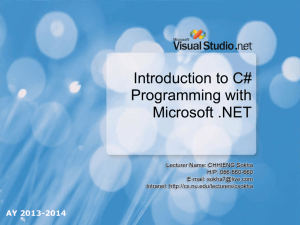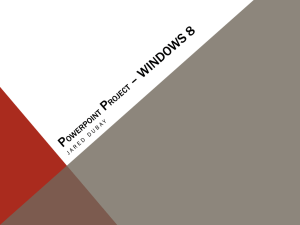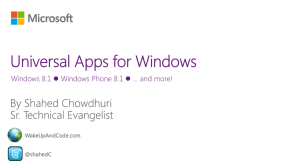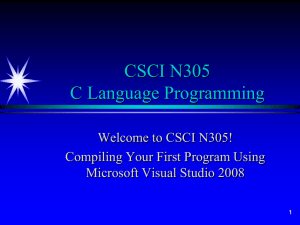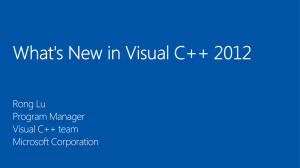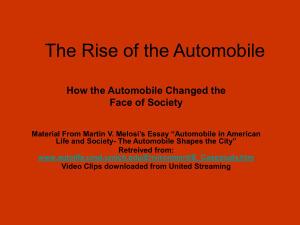Slides - Chapter 1
advertisement
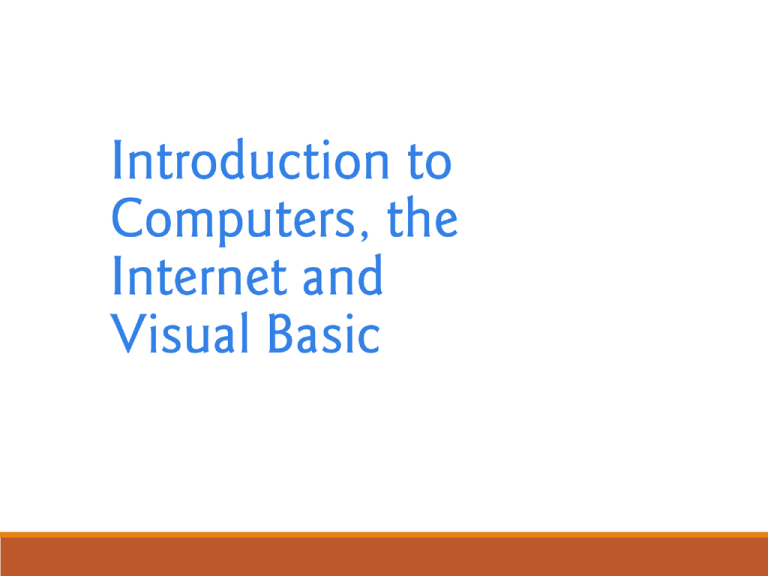
Important Information Visual Studio 2013 ◦ www.dreamspark.com ◦ www.visualstudio.com Course web site ◦ http://www.condesigns.com Contact ◦ Office Hours – Upon request ◦ E-mail: adepinto@gmail.com Introduction •Computers process data under the control of sequences of instructions called computer programs. •These programs guide the computer through actions specified by people called computer programmers. •The programs that run on a computer are referred to as software. Hardware and Moore’s Law •A computer consists of various devices referred to as hardware, such as the keyboard, screen, mouse, hard disks, memory, DVD drives, printer and processing units). •Every year or two, the capacities of computer hardware have approximately doubled inexpensively. •This remarkable trend often is called Moore’s Law, named for the person who identified it, Gordon Moore, co-founder of Intel. Computer Organization •Regardless of differences in physical appearance, computers can be envisioned as divided into various logical units or sections: • Input Unit - Most information is entered into computers through keyboards, touch screens and mouse devices. • Output Unit - Most information that’s output from computers today is displayed on screens; printed on paper; played as audio or video on PCs and media players, etc. • Memory Unit - It also retains processed information until it can be placed on output devices by the output unit. Information in the memory unit is volatile—it’s typically lost when the computer’s power is turned off. • Central Processing Unit (CPU) - Tells the input unit when information should be read into the memory unit, tells the output unit when to send information from the memory unit to certain output devices Data Hierarchy •Data items processed by computers form a data hierarchy that becomes larger and more complex in structure as we progress from the simplest data items (called “bits”) to richer data items, such as characters, fields, and so on. Data Hierarchy • Bits - The smallest data item in a computer can assume the value 0 or the value 1. • Characters - We prefer to work with decimal digits (0– 9), uppercase letters (A–Z), lowercase letters (a–z), and special symbols. Computers process only 1s and 0s, so every character is represented as a pattern of 1s and 0s. ASCII Table • Bits - The smallest data item in a computer can assume the value 0 or the value 1. • Characters - We prefer to work with decimal digits (0– 9), uppercase letters (A–Z), lowercase letters (a–z), and special symbols. Computers process only 1s and 0s, so every character is represented as a pattern of 1s and 0s. Data Hierarchy • Fields - Just as characters are composed of bits, fields are composed of characters or bytes. A field is a group of characters or bytes that conveys meaning. For example, a field consisting of uppercase and lowercase letters could be used to represent a person’s name, and a field consisting of decimal digits could represent a person’s age. Data Hierarchy Records Several related fields can be used to compose a record. In a payroll system, for example, the record for an employee might consist of the following fields (possible types for these fields are shown in parentheses): ◦ ◦ ◦ ◦ ◦ ◦ Employee identification number (a whole number) Name (a string of characters) Address (a string of characters) Hourly pay rate (a number with a decimal point) Year-to-date earnings (a number with a decimal point) Amount of taxes withheld (a number with a decimal point) Thus, a record is a group of related fields. Data Hierarchy • Files - A file is a group of related records. • Database - A database is a collection of data that’s organized for easy access and manipulation. The most popular database model is the relational database in which data is stored in simple tables. A table includes records composed of fields. ◦ For example, a table of students might include first name, last name, major, year, student ID number and grade point average fields. ◦ The data for each student is a record, and the individual pieces of information in each record are the fields. Machine Languages, Assembly Languages and High-Level Languages ◦ Machine Languages - Any computer can directly understand only its own machine language, defined by its hardware architecture. Machine languages generally consist of numbers, ultimately reduced to 1s and 0s. ◦ Assembly Languages and Assemblers - Machine language too slow and tedious. Assembly language uses abbreviations to represent elementary operations. Translator programs called assemblers convert assemblylanguage programs to machine language quickly. ◦ High-Level Languages, Compilers and Interpreters - developed so single statements could be written to accomplish substantial tasks. Translator programs called compilers convert high-level-language code into machine language code. Machine Languages, Assembly Languages and High-Level Languages Programming Languages—Procedural, Event Driven, and Object Oriented Procedural—Cobol, Fortran, Basic ◦ Program specifies exact sequence of all operations. Event-Driven Programming(VB 6.0 and previous) ◦ Contain some elements of object-oriented programming, but not all. Lacks Inheritance and Polymorphism. Object-Oriented Programming (OOP) (VB .NET) ◦ Based on objects with attributes and behaviors. Can generate and respond to events. Object Technology Objects, or more precisely the classes objects come from, are essentially reusable software components. ◦ There are date objects, time objects, audio objects, video objects, automobile objects, people objects, etc. ◦ Objects equate to Nouns. ◦ Forms are windows. ◦ Controls are components contained inside a form. ◦ Properties equate to Adjectives. ◦ Color or size of a Form ◦ Methods are like Verbs. ◦ Typical methods include Close, Show and Clear Object Technology •Class = Automobile •Properties of Automobile class= make, model, color, year • Car.color = Red •Object = Each individual auto is an object. • Object is also an Instance of the automobile class. •Methods = start, stop, speedup, slowdown • Car.Start(), Car.Stop(), Car.Brake() • Pressing Brake causes the car to stop. “How” is hidden though. •Events of automobile class = Arrive, Crash Object Technology - Class •In object-oriented programming languages, we create a program unit called a class to house the set of methods that perform the class’s tasks. •A class is similar in concept to a car’s engineering drawings, which house the design of an accelerator pedal, steering wheel, and so on. •Enables people with little or no knowledge of how engines, braking and steering mechanisms work to drive a car easily. Object Technology - Instances Making Objects from Classes You must build an object from a class before a program can perform the tasks that the class’s methods define. The process of doing this is called instantiation. An object is then referred to as an instance of its class. Reuse Reuse of existing classes when building new classes and programs saves time and effort. Helps you build more reliable and effective systems, because existing classes and components often have gone through extensive testing, debugging and performance tuning. Object Technology Encapsulation Classes encapsulate (i.e., wrap) attributes and methods into objects—an object’s attributes and operations are intimately related. Objects may communicate with one another, but they’re normally not allowed to know how other objects are implemented—implementation details are hidden within the objects themselves. Information hiding is crucial to good software engineering. Object Technology Inheritance A new class of objects can be created quickly and conveniently by inheritance—the new class absorbs the characteristics of an existing class, possibly customizing them and adding unique characteristics of its own. In our car analogy, an object of class “convertible” certainly is an object of the more general class “automobile,” but more specifically, the roof can be raised or lowered. Reuse Vehicle / \ Car / Truck \ Coupe Sedan / \ Pickup Extended Cab Visual Basic •Visual Basic evolved from BASIC (Beginner’s All-purpose Symbolic Instruction Code), developed in the mid-1960s at Dartmouth College as a language for introducing novices to fundamental programming techniques. •In the late 1980s and the early 1990s, Microsoft developed its Windows graphical user interface (GUI)— the visual part of the operating system with which users interact. Visual Basic •With the creation of the Windows GUI, the natural evolution of BASIC was to Visual Basic, introduced by Microsoft in 1991 to make programming Windows apps easier. •Visual Basic 6 was introduced in 1998. It was designed to make programming fast and easy, however it was not intended for building industrial strength apps. •In 2002, Microsoft released Visual Basic .NET—a more robust language that’s appropriate for the most demanding app development tasks. Microsoft’s .NET •In 2000, Microsoft announced its .NET initiative, a broad vision for using the Internet and the web in the development, engineering, distribution and use of software. •.NET permits developers to create apps in any .NETcompatible language (such as Visual Basic, C# and others). •Part of the initiative includes Microsoft’s ASP.NET technology, which is used to create web apps that users interact with via their web browsers. Common Language Runtime •The Common Language Runtime (CLR) executes .NET programs and provides functionality to make them easier to develop and debug. •The CLR is a virtual machine (VM)—software that manages the execution of programs and hides from them the underlying operating system and hardware. •The source code for programs that are executed and managed by the CLR is called managed code. Visual Studio .NET Included in Visual Studio .NET 2013 ◦ Visual Basic (can also be purchased separately) ◦ Visual C++ ◦ C# (C sharp) ◦ J# (J sharp) ◦ F# (F sharp) ◦ .NET 4.0 Framework Visual Studio .NET Editions ◦ Community ◦ Professional ◦ Premium/Ultimate Object-Oriented Programming Visual Basic .NET is object oriented. Visual Basic has access to the powerful .NET Framework Class Library—a vast collection of prebuilt components that enable you to develop apps quickly. Visual Programming •Visual Basic is event driven. You’ll write programs that respond to user-initiated events such as mouse clicks, keystrokes, timer expirations, etc. •Visual Basic is a visual programming language—in addition to writing program statements to build portions of your apps, you’ll also use Visual Studio’s graphical user interface (GUI) to conveniently drag and drop predefined objects like buttons and textboxes into place on your screen, and label and resize them. •Visual Studio will write much of the GUI code for you.
